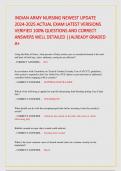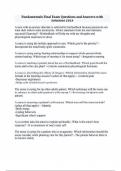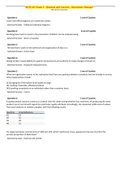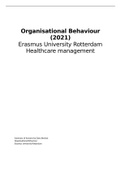Exam (elaborations)
INDIAN ARMY NURSING NEWEST UPDATE ACTUAL EXAM LATEST VERISIONS VERIFIED 100% QUESTIONS AND CORRECT ANSWERS WELL DETAILED ||ALREADY GRADED A+
- Course
- NURS 400 (NURS)
- Institution
- Indiana University Of Pennsylvania
INDIAN ARMY NURSING NEWEST UPDATE ACTUAL EXAM LATEST VERISIONS VERIFIED 100% QUESTIONS AND CORRECT ANSWERS WELL DETAILED ||ALREADY GRADED A+ INDIAN ARMY NURSING NEWEST UPDATE ACTUAL EXAM LATEST VERISIONS VERIFIED 100% QUESTIONS AND CORRECT ANSWERS WELL DETAILED ||ALREADY GRADED...
[Show more]






